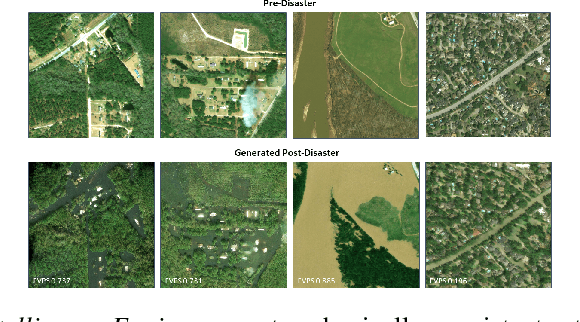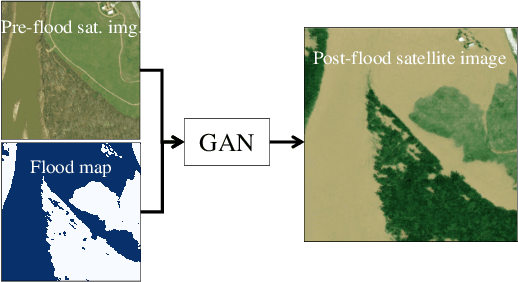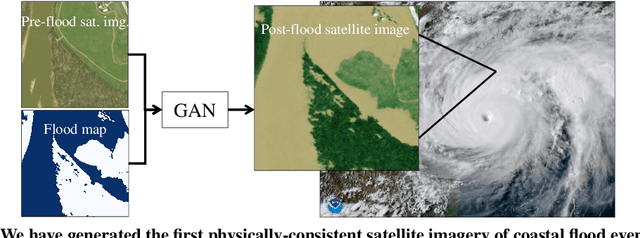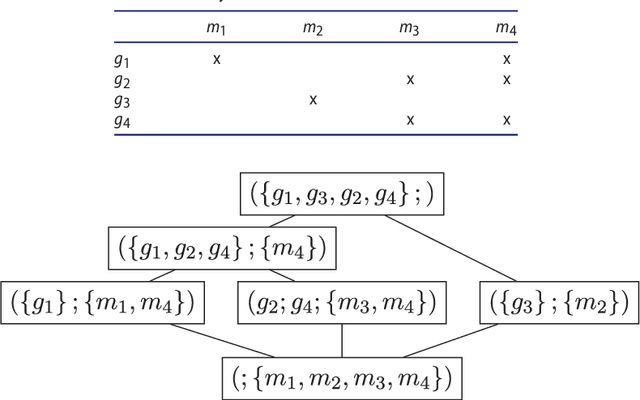Chedy Raïssi
Physically-Consistent Generative Adversarial Networks for Coastal Flood Visualization
May 05, 2021



Abstract:As climate change increases the intensity of natural disasters, society needs better tools for adaptation. Floods, for example, are the most frequent natural disaster, and better tools for flood risk communication could increase the support for flood-resilient infrastructure development. Our work aims to enable more visual communication of large-scale climate impacts via visualizing the output of coastal flood models as satellite imagery. We propose the first deep learning pipeline to ensure physical-consistency in synthetic visual satellite imagery. We advanced a state-of-the-art GAN called pix2pixHD, such that it produces imagery that is physically-consistent with the output of an expert-validated storm surge model (NOAA SLOSH). By evaluating the imagery relative to physics-based flood maps, we find that our proposed framework outperforms baseline models in both physical-consistency and photorealism. We envision our work to be the first step towards a global visualization of how climate change shapes our landscape. Continuing on this path, we show that the proposed pipeline generalizes to visualize arctic sea ice melt. We also publish a dataset of over 25k labelled image-pairs to study image-to-image translation in Earth observation.
Rediscovering alignment relations with Graph Convolutional Networks
Nov 11, 2020



Abstract:Knowledge graphs are concurrently published and edited in the Web of data. Hence they may overlap, which makes key the task that consists in matching their content. This task encompasses the identification, within and across knowledge graphs, of nodes that are equivalent, more specific, or weakly related. In this article, we propose to match nodes of a knowledge graph by (i) learning node embeddings with Graph Convolutional Networks such that similar nodes have low distances in the embedding space, and (ii) clustering nodes based on their embeddings. We experimented this approach on a biomedical knowledge graph and particularly investigated the interplay between formal semantics and GCN models with the two following main focuses. Firstly, we applied various inference rules associated with domain knowledge, independently or combined, before learning node embeddings, and we measured the improvements in matching results. Secondly, while our GCN model is agnostic to the exact alignment relations (e.g., equivalence, weak similarity), we observed that distances in the embedding space are coherent with the "strength" of these different relations (e.g., smaller distances for equivalences), somehow corresponding to their rediscovery by the model.
Physics-informed GANs for Coastal Flood Visualization
Oct 16, 2020



Abstract:As climate change increases the intensity of natural disasters, society needs better tools for adaptation. Floods, for example, are the most frequent natural disaster, but during hurricanes the area is largely covered by clouds and emergency managers must rely on nonintuitive flood visualizations for mission planning. To assist these emergency managers, we have created a deep learning pipeline that generates visual satellite images of current and future coastal flooding. We advanced a state-of-the-art GAN called pix2pixHD, such that it produces imagery that is physically-consistent with the output of an expert-validated storm surge model (NOAA SLOSH). By evaluating the imagery relative to physics-based flood maps, we find that our proposed framework outperforms baseline models in both physical-consistency and photorealism. While this work focused on the visualization of coastal floods, we envision the creation of a global visualization of how climate change will shape our earth.
On mining complex sequential data by means of FCA and pattern structures
Apr 09, 2015



Abstract:Nowadays data sets are available in very complex and heterogeneous ways. Mining of such data collections is essential to support many real-world applications ranging from healthcare to marketing. In this work, we focus on the analysis of "complex" sequential data by means of interesting sequential patterns. We approach the problem using the elegant mathematical framework of Formal Concept Analysis (FCA) and its extension based on "pattern structures". Pattern structures are used for mining complex data (such as sequences or graphs) and are based on a subsumption operation, which in our case is defined with respect to the partial order on sequences. We show how pattern structures along with projections (i.e., a data reduction of sequential structures), are able to enumerate more meaningful patterns and increase the computing efficiency of the approach. Finally, we show the applicability of the presented method for discovering and analyzing interesting patient patterns from a French healthcare data set on cancer. The quantitative and qualitative results (with annotations and analysis from a physician) are reported in this use case which is the main motivation for this work. Keywords: data mining; formal concept analysis; pattern structures; projections; sequences; sequential data.
 Add to Chrome
Add to Chrome Add to Firefox
Add to Firefox Add to Edge
Add to Edge